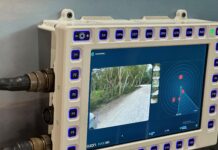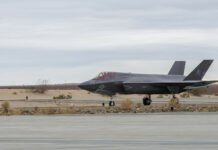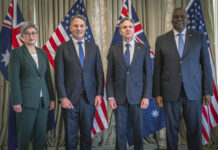Just prior to the Singapore Airshow to be held from February 11-16, it was learned that the Republic of Singapore Air Force (RSAF) and Navy (RSN) will combine their operational capabilities with the procurement of F-35B short take-off and vertical landing (STOVL) fifth-generation stealth fighter aircraft. The U.S. Defense Security Cooperation Agency’s Foreign Military Sales Programme Office announced in January the release of four F-35Bs with the option to procure an additional eight aircraft and up to 13 F135 engines and related equipment for an estimated US$2.750 billion.
The initial F-35B order is for 12 aeroplanes and falls in line with the RSAF long-term plans to retire their F-16 fleet and the closure of Paya Lebar Air Base (some aircraft will be transferred to Tengah and Changi) by 2030. The RSAF took deliveries of its F-16C/D Block 52 aircraft in 2003 under the Peace Calvin IV programme.
There is also strong evidence to support the belief that Singapore’s plans to build 14,000-tonne helicopter carriers (dubbed the Joint Multi-Mission Ship or JMMS) are actually a cover to build a F-35 carrier modelled after the Japanese version.
The Japanese Self-Defence Forces employed the same low-key approach when they first built their “helicopter-destroyer” many years ago, only hinting that the it could possibly handle F-35s with a reinforced landing deck. Later builds saw this modification come to fruition with newer helicopter-destroyers that could handle the tiltrotor V-22 Osprey vertical and/or short take-off and landing (V/STOL) troop transport. In comparison, the empty weight of around 14,000 kg for the F-35B and V-22, individually, make the Japanese “carrier” a potential F-35B launch platform as future modifications continue.
The five 7,000-tonne ENDURANCE class landing platform decks have short aft landing areas for helicopters. Perhaps the F-35B could land on one during an emergency, but the Endurance is not a carrier in the conventional sense. Instead, there are suggests the Endurance be the model for a full-carrier capable JMMS.
The F-35B is one of the three variants of the US-made fighter aeroplane that was initially developed to meet both the U.S. Marine Corps and UK Royal Navy requirement to replace the different models of the STOVL Harrier fighter aircraft. Aside from being designed to be a stealthy aircraft, the F-35B version’s design utilises a gear-coupled lift fan that is powered by the aircraft’s single F135 engine. This deletes the need for (and the associated weight) that the Harrier has by having a secondary lift engine on-board that is separate from the main powerplant.
The RSAF plan was first announced in 2013, and the force plan to transfer remaining operations to Changi Air Base (East and West), home of its logistical support aircraft. The 40 F-15SGs will remain in service, which along with the F-35s will give the force a majority of aircraft equipped with Active Electronically Scanning Array (AESA) radars. This augments the ability of the RSAF to utilise fighters as battle-space management assets in addition to their basic role as weapons platforms.
But, reducing air power options with the elimination of both an air base and three squadrons of 60 F-16s appears to be less than acceptable to the city-state’s military. Though Indonesia and Malaysia are hardly military heavy-weights, there is still an underlying anxiety in the Singaporean mindset on maintaining command and control over the Malacca Strait. Fears of being squeezed by its neighbours via the narrow shipping lane, drives much of its defence procurement priorities.
A NATO diplomat who spoke to EDS explained how part of Singapore’s fears about both the enviousness of its neighbours and its geographic position is rooted in past history.
“This is a country that sits astride a steady flow of shipborne commerce and it enjoys a position of being the crossroads of Asia,” he said. “The country is on the top of the Pacific Rim nations in terms of modernity, trading, commerce, etc. But then they remember that Venice, Italy at one time was the trading capital of the known world and now today it is a place for tourists to visit and be serenaded by gondoliers. In the back of the minds of Singapore’s rulers, there is always this fate which they want to make sure that they avoid.”
Singapore and Israel are categorised as Security Cooperative Participants (SCP) in the F-35 programme and were latecomers to the three levels originally ordained for the programme, with the US as the primary customer, UK as Level 1, Italy and Netherlands as Level 2, and Australia, Canada, Israel, Norway, and Turkey as Level 3 Partners. Though Turkey is now facing exclusion from the programme by the US Congress due to Ankara’s decision to purchase the Almaz-Antei S-400 air defence system from Russia. Turkey has even announced plans to purchase Sukhoi Su-35 aircraft to compensate for the F-35s it is most likely not going to receive.
Other F-35 export customers in Asia include Japan, Australia and South Korea. India has been discussed as a potential customer as well, but much of this hinges on what procurement is the ultimate decision when New Delhi turns its Medium Multi-Role Combat (MMRCA) fighter competition back on again for 126 aircraft for the Indian Air Force. The MMRCA has been plagued with problems for over a decade due to freakish offset demands, hints of corruption, and hostility to the U.S. due to support for Pakistan, their arch enemy.
The Republic of China (ROC) on Taiwan was seen by many as a potential customer, but in 2019 Taipei selected 66 F-16V fighters to replace its ageing Mirage 2000-5 fleet. The ROC Air Force are also currently upgrading its older F-16C/D Block 50/52 with AN/APG-83 Scalable Agile Beam Radar (SABR) as its active electronically scanned array (AESA) selection over Raytheon Advanced Combat Radar (RACR).
Taiwan is also modernizing its ageing AIDC F-CK-1 Ching-Kuo Indigenous Defence Fighter (IDF) fleet with new radar, avionics, and new weapons suite.
The Singaporeans are famous for their scrupulous attention to every detail of a new weapon purchase and the initial batch of four aircraft to be procured will likely undergo gruelling testing before any additional aircraft are ordered. Further orders could include demands for modifications that will include advice on modifications from the Israeli Air Force (IAF) and its associated defence contractors and suppliers that historically work closely with Singapore.
Israeli industry made extensive modifications to the RSAF F-16s, in many respects mirroring the modifications it made to its own aircraft. These include the integration of Israeli-design electronic warfare (EW) systems.
The IAF are expected to procure the F-35A conventional take-off and landing (CTOL) variant and thus have an interest in cooperating with and becoming part of the RSAF programme in the same manner that they became a player in the development of the Singapore variants of the F-16. Singapore’s procurement of the F-35B may also aid the IAF as being an early test bed for the aircraft in a crowded urban environment.
There are also real fears that Israel and Singapore face. Both countries have no strategic depth and are surrounded by Muslim countries. This has forced both countries to adopt an offensive military strategy and the stealthy F-35 fits in nicely with that strategy.
There is also speculation on whether the RSAF will rename their variant of the F-35B, after all modification requests are undertaken by Lockheed Martin. One nickname being bandied about is “Merlion”, which is the official mascot of Singapore and based on a mythical creature that has a lion head and a fish body.
Such changes are not without historical precedence: U.S. fighter pilots have already changed the name of the fighter from the awkward name of “Lightening II” to “Panther”, and the F-16 “Fighting Falcon” is better known as the “Viper”; the A-10 “Thunderbolt” was quickly renamed the “Warthog” for obvious reasons; and the U-2 spy plane earned the nickname “Dragon Lady” due to the difficulty it was to fly and how unforgiving it could be for the pilot who made a mistake, often fatal.
Wendell Minnick











